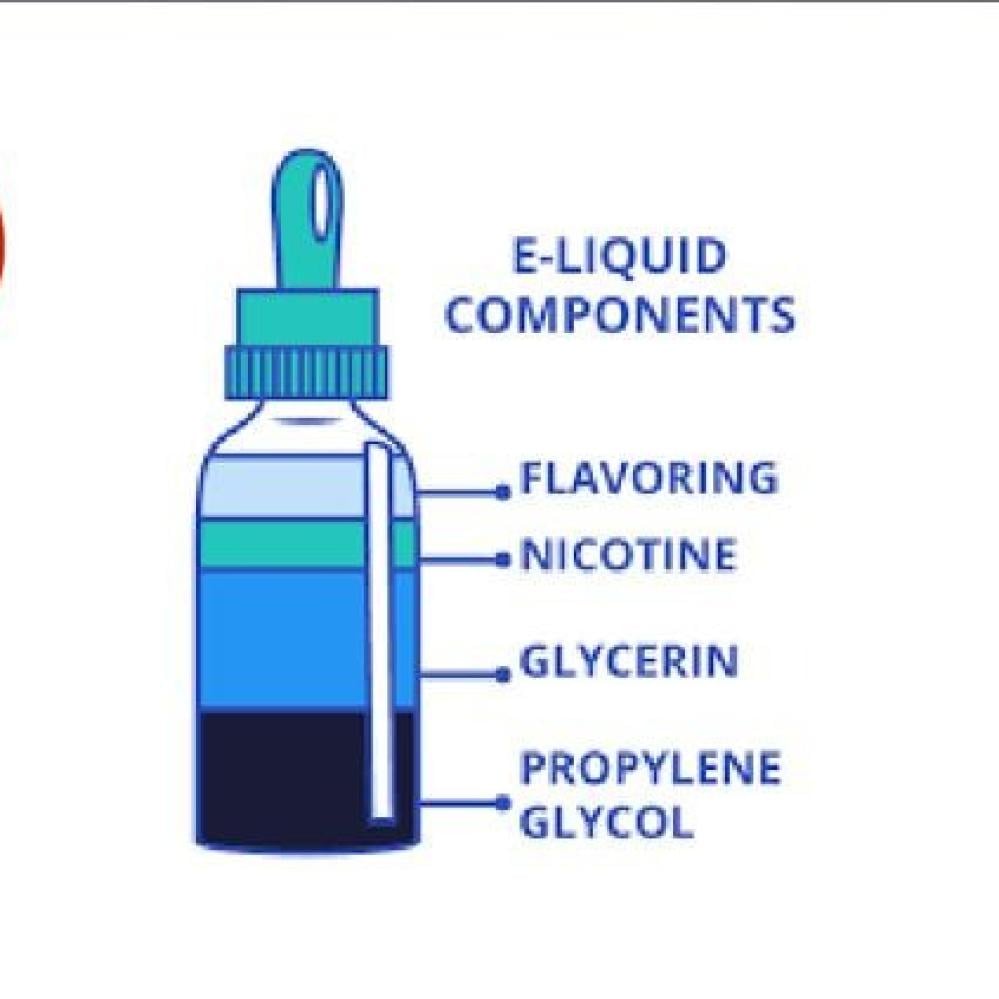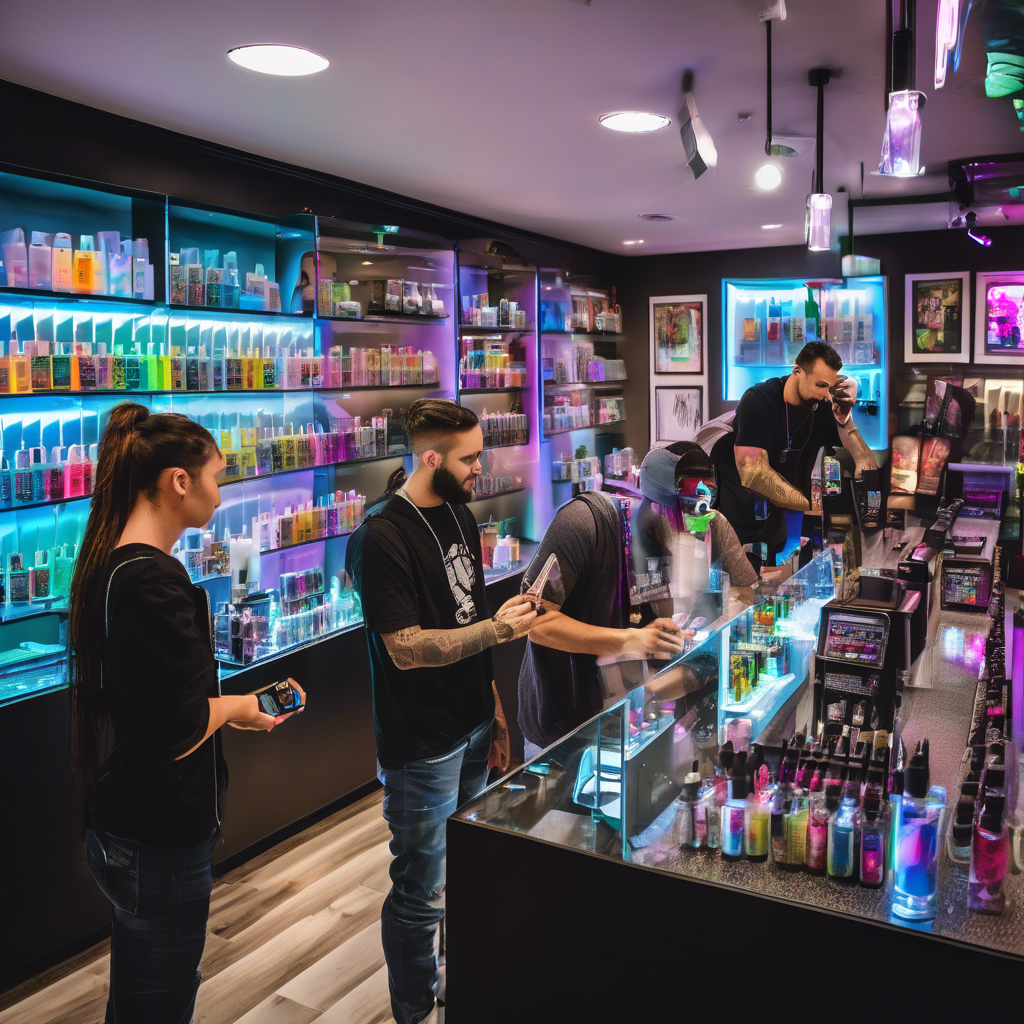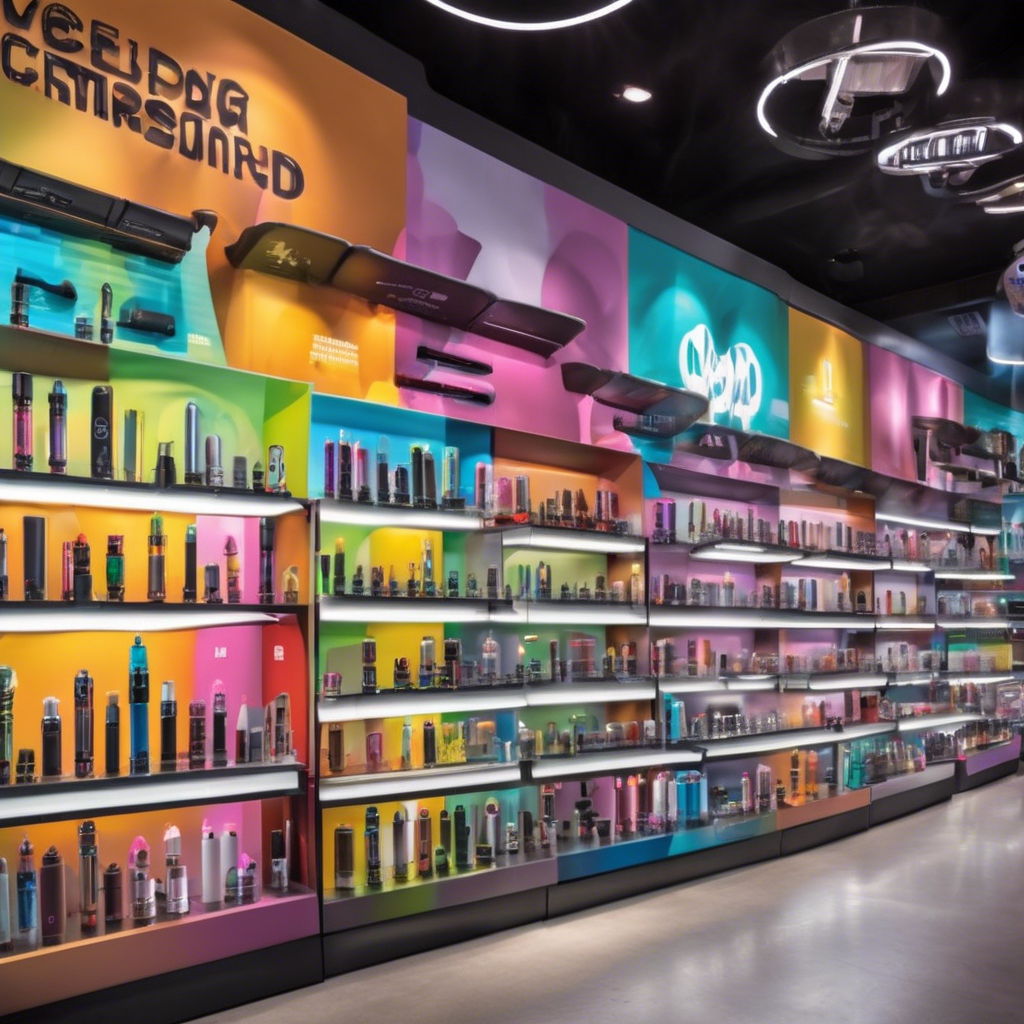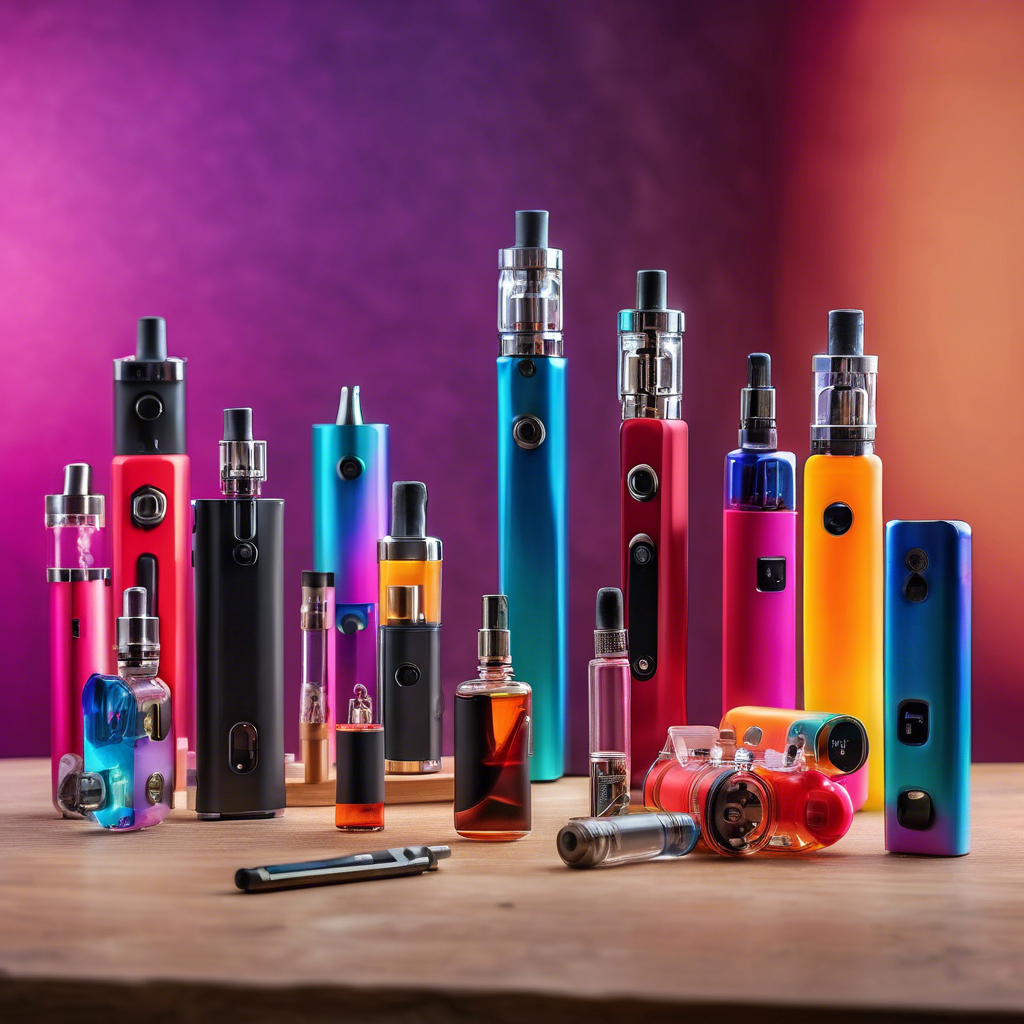

Welcome to Our In-Depth Guide on E-Cigarette Liquids
Explore what truly lies within your vape with our comprehensive guide, "What’s Inside Your Vape? A Deep Dive into E-Cigarette Liquid Components". As vaping becomes increasingly popular, understanding e-cigarette liquids and their key ingredients is crucial. Uncover the science behind e-cigarette fluids, and gain insights into everything you should know about E-Liquid 101 - from breaking down the basics of VG (Vegetable Glycerin), PG (Propylene Glycol), and various flavorings.
Ever wondered "What Are E-Liquids Made Of?" Our guide provides you with a detailed look at common ingredients, ensuring a thorough understanding of the composition and chemistry involved. Discover the essential components that influence your vaping experience and learn about the potential safety and quality concerns.
Dive into the world of propylene glycol, nicotine, and the critical role flavorings play in e-cigarette liquids. We're here to demystify e-liquid ingredients, questioning their safety and what makes these fluids tick. Whether you are new to vaping or looking to enhance your knowledge, our guide, "The Essential Guide to E-Cigarette Liquid Ingredients," serves as your go-to resource.
Before you vape, equip yourself with knowledge about e-cigarette liquid ingredients—from flavorings to additives. Understanding these compounds ensures safer vaping choices. Here, the truth about e-liquid compounds is laid bare so that you can vape with confidence and awareness. Explore, learn, and vape smarter with our expertly curated content.

Understanding E-Cigarette Liquids: Key Ingredients
As individuals delve into the world of vaping, it becomes essential to understand the ingredients that make up e-cigarette liquids. Among these components, Propylene Glycol (PG) and Vegetable Glycerin (VG) are two of the most fundamental.
Overview of Propylene Glycol (PG) and Vegetable Glycerin (VG)
PG and VG are both clear, odorless liquids that serve pivotal roles in e-cigarette formulations:
- Propylene Glycol (PG): This is a synthetic, colorless liquid that is commonly used in a variety of food products, pharmaceuticals, and cosmetics. PG is known for its low viscosity and ability to produce a throat hit similar to traditional smoking, which makes it popular among vapers transitioning from cigarettes.
- Vegetable Glycerin (VG): Derived from vegetable oils, VG is a thicker, sweeter liquid often found in food and cosmetic products. It is liked for its capacity to produce large vapor clouds, providing a smooth and sweet experience during vaping.
Understanding both ingredients helps consumers make informed choices about their vaping preferences.
Roles of PG and VG in E-Cigarette Liquids
So, what roles do PG and VG play within e-cigarette liquids? Here’s a breakdown:
- Vapor Production: VG is responsible for generating the vapor that users inhale. Its thicker consistency contributes to the cloud-like output that many vapers enjoy.
- Flavor Carrier: Both PG and VG serve as carriers for flavorings. However, PG is particularly effective at enhancing flavor, making it a go-to for many e-liquid manufacturers.
- Nicotine Delivery: PG's properties help in the absorption of nicotine into the bloodstream, mimicking the sensation smokers might experience from traditional cigarettes.
In conclusion, PG and VG are more than just fillers; they significantly contribute to the vaping experience, impacting taste, throat hit, and vapor production. By understanding these ingredients better, users can tailor their vaping experience to suit their preferences, leading to a safer and more satisfying choice in e-liquids.
The Science Behind E-Cigarette Fluids
Having explored the key ingredients in e-cigarette liquids, it’s important to transition into the regulatory landscape and safety considerations surrounding these components. Understanding how substances like Propylene Glycol (PG) and Vegetable Glycerin (VG) are viewed by health authorities can guide users in making safer choices.
FDA Approval of PG and VG
The U.S. Food and Drug Administration (FDA) plays a crucial role in regulating substances used in food and personal care products, including e-liquids.
- GRAS Status: PG and VG have been designated as Generally Recognized As Safe (GRAS) by the FDA for use in food and pharmaceutical applications. This means these substances are considered safe when used as intended.
- Ongoing Research: While PG and VG have been used in various industries, the FDA continues to monitor research on their safety in the context of vaping. As regulations evolve, it’s pivotal for users to stay informed about potential updates.
Safety Considerations of Inhaling PG and VG
Although PG and VG are recognized for their safety in food and cosmetics, inhalation introduces new considerations:
- Respiratory Effects: Some individuals may experience irritation of the respiratory tract when inhaling PG, leading to symptoms like coughing or a dry throat. This varies among users, and many vapers find that they prefer VG-based liquids for a smoother experience.
- Allergic Reactions: A small percentage of users may develop allergies or sensitivities to PG. If someone finds themselves experiencing unusual symptoms after using e-liquids, switching to a VG-only formulation can provide relief.
In conclusion, while PG and VG are largely recognized as safe, understanding their regulatory background and potential effects on inhalation fosters responsible vaping habits. Awareness empowers users to make informed decisions about their e-liquids, ultimately prioritizing their health and well-being.
E-Cigarette Liquid Components Breakdown
With a good grasp of the fundamental ingredients and their safety considerations, it’s time to delve into one of the most compelling aspects of e-cigarette liquids: flavorings. These components not only enhance the vaping experience but also add a layer of complexity to the formulation of e-liquids.
Significance of Flavorings in E-Liquids
Flavorings are the magic ingredient that transforms plain e-liquids into a delightful vaping experience. They serve several purposes:
- Variety and Enjoyment: Flavorings add an array of choices to the market, from fruity and sweet to savory and dessert-like profiles. This variety caters to individual preferences, enabling vapers to explore different experiences. For example, a user might switch from a traditional tobacco flavor to a refreshing mint or a decadent chocolate cake flavor based on mood or occasion.
- Transition Aid for Smokers: Flavorings can help smokers transition from traditional cigarettes. Many vapers find that flavor profiles better suit their tastes, making the switch to vaping more appealing.
However, while flavorings contribute significantly to the allure of vaping, it’s crucial to understand their risks as well.
Risks Associated with Inhaling Flavoring Chemicals
Despite their widespread use, inhaling flavoring chemicals is not without concerns:
- Chemical Composition: Some flavorings are composed of substances that may not be safe when heated and inhaled. For instance, certain diketones like diacetyl, commonly used in buttery flavorings, have been linked to respiratory issues and a condition known as "popcorn lung."
- Allergic Reactions: Users may experience allergic reactions to certain flavoring compounds, leading to respiratory discomfort, skin irritation, or other symptoms.
In summary, while flavorings significantly enhance the enjoyment of e-liquids, it is essential for users to remain vigilant about their safety. Being informed about the types of flavorings used in e-liquids can empower vapers to make choices aligned with their health and preferences. By considering both enjoyment and risk, vapers can create a gratifying yet responsible vaping experience.
Composition of E-Liquids
As we continue our exploration of e-liquid components, the role of nicotine emerges as a crucial facet. Understanding nicotine's function not only enhances the overall vaping experience but also informs users about its effects and implications.
Role of Nicotine in E-Liquids
Nicotine is a naturally occurring stimulant found in tobacco plants, and it plays a significant role in e-liquids for several reasons:
- Addiction and Satisfaction: For many smokers transitioning to vaping, nicotine provides a familiar sense of satisfaction. It triggers the release of dopamine, the “feel-good” neurotransmitter, making it a key component in the desire to vape.
- Throat Hit: Nicotine contributes to the throat hit—a sensation that many former smokers seek. This sensation helps replicate the experience of smoking traditional cigarettes, potentially easing the transition.
However, knowing the right nicotine strengths is important for a balanced vaping experience.
Importance of Choosing Appropriate Nicotine Levels
Selecting the correct nicotine level is vital to match individual preferences and needs:
- Nicotine Strength Options: E-liquids come in various nicotine strengths, typically ranging from 0 mg/ml (nicotine-free) up to 24 mg/ml or even higher. Users can choose based on their previous smoking habits. A heavier smoker might opt for higher levels initially, then gradually reduce it to lower strengths over time.
- Health Considerations: Understanding the impacts of long-term nicotine use is essential. While nicotine itself isn’t the leading cause of smoking-related health issues, the dependencies it creates can be concerning. For those with a history of heart conditions or anxiety disorders, lower nicotine levels might be advisable.
In summary, nicotine plays a fundamental role in e-liquids, impacting user satisfaction and experience. By choosing the appropriate nicotine level, vapers can tailor their experience to suit their lifestyle and health considerations, leading to safer and more enjoyable vaping.
Safety and Quality Concerns of E-Cigarette Liquids
With a deeper understanding of e-liquid components, such as nicotine, it’s critical to address safety and quality concerns when it comes to e-cigarette liquids. The growing popularity of vaping has led to an influx of products on the market, making it increasingly important to navigate choices wisely.
Importance of Purchasing From Reputable Brands
When it comes to e-cigarettes, brand reputation matters. Purchasing liquids from well-known, reputable brands can significantly reduce the risk of safety issues.
- Quality Assurance: Established brands typically adhere to stringent production standards. Many invest in quality control measures, ensuring their products are safe for consumption. For example, brands that have undergone third-party testing provide an added layer of confidence for consumers.
- Consumer Reviews: Checking online reviews or seeking recommendations from fellow vapers can guide users toward trustworthy brands. Hearing firsthand experiences can often spotlight both the pros and cons of specific products.
Transparent Ingredient Lists and Trusted Sources
Transparency is key when it comes to e-liquids. Consumers should feel empowered to scrutinize ingredient lists before making a purchase.
- Ingredient Disclosure: Quality e-liquid manufacturers will openly disclose their ingredient lists, including VG, PG, flavorings, and nicotine levels. Brands that hide or obfuscate this information may raise red flags. For instance, if a brand cannot clearly state what’s in their liquid, it’s best to steer clear.
- Trusted Retailers: Buying from reputable retailers—whether online or at brick-and-mortar shops—ensures that products meet safety standards. Ideally, choose retailers known for sourcing from established brands and offering authentic products.
In conclusion, the safety and quality of e-cigarette liquids hinge on making informed purchasing choices. By opting for reputable brands and demanding transparency in ingredient listings, vapers can prioritize their health and well-being while enjoying the experience of vaping. This approach empowers users to make better decisions, leading to a safer and more enjoyable vaping journey.
Comprehensive Understanding of E-Cigarette Liquid Components
As we delve deeper into e-liquids, it becomes essential to explore additional additives that can be found alongside the primary ingredients like VG, PG, and nicotine. Understanding these additives and their implications can provide users with a more holistic view of what they are inhaling.
Exploring Additional Additives in E-Liquids
Beyond the main components, many e-liquids also contain various additives that enhance flavor, stability, or user experience. Some common additives include:
- Sweeteners: Commonly used to enhance flavor and mimic the sweetness of traditional cigarettes or candies. While these can improve the taste, excessive sweetness may lead to residue build-up on coils, affecting performance.
- Menthol and Cooling Agents: Popular among users who enjoy a refreshing sensation, these additives provide a cool throat hit. However, it's worth considering how they might affect those with respiratory sensitivities.
- Coloring Agents: While these are typically harmless, some users prefer avoiding colored liquids, believing they may indicate the presence of unnecessary chemicals.
Being informed about these additives allows vapers to make choices that align with their personal preferences and health considerations.
Considerations for Safety and Health Implications
While many additives are generally considered safe, it’s essential for consumers to weigh potential health implications:
- Research and Regulation: Not all additives have been extensively studied, especially in the context of inhalation. Understanding that vaping is a relatively new phenomenon means that ongoing research is crucial.
- Individual Sensitivities: Some users may have allergies or sensitivities to specific substances. Monitoring how your body reacts to different e-liquids can be beneficial for those with known sensitivities.
In conclusion, a comprehensive understanding of e-liquid components, including additional additives, empowers users to make informed decisions about their vaping experience. By recognizing potential health implications and individual sensitivities, vapers can choose products that not only enhance enjoyment but also prioritize their well-being in an ever-evolving landscape of vaping.
Impact of Flavorings in E-Cigarette Liquids
Continuing our exploration of e-cigarette liquids, it’s essential to focus on flavorings, which play a pivotal role in shaping the vaping experience. While they enhance enjoyment, it’s equally important to understand their associated risks.
Enhancements and Risks of Flavorings
Flavorings are the heart of many e-liquids, providing variety and satisfaction to users.
- Diversity of Choices: From fruity delights to dessert flavors, flavorings make vaping a customizable experience. This diversity allows individuals to explore tastes that may resonate with their personal preferences, making it less likely for them to miss traditional cigarettes.
- Aiding Cessation: Many smokers find that flavorful e-liquids help ease the transition from smoking to vaping. For instance, a sweet candy flavor can make the experience more enjoyable and less daunting for those moving away from nicotine dependence.
However, the enhancement of flavors brings certain risks that users should acknowledge:
- Health Risks of Certain Flavorings: Some flavoring agents, particularly those that come from food-grade sources, may not be safe for inhalation. For example, compounds like diacetyl, known for its buttery taste, have been linked to serious lung conditions.
- Potential Allergens: Users may unknowingly have allergies or sensitivities to specific flavoring agents, resulting in respiratory discomfort or allergic reactions.
Stay Informed on Health Effects and Regulatory Updates
As the market continues to evolve, staying informed is crucial:
- Ongoing Research: Scientific studies are consistently emerging, revealing new insights into the safety of various flavorings in e-liquids. Vapers should keep an eye on these developments to make educated choices about their products.
- Regulatory Changes: Regulatory bodies, such as the FDA, are adapting to new findings about flavorings. Being aware of these updates not only aids in compliance but also ensures that consumers are consuming the safest products available.
In conclusion, while flavorings significantly enhance the vaping experience, it's essential for users to remain aware of potential risks and stay informed on health effects and regulatory changes. By doing so, vapers can enjoy a fulfilling experience while also prioritizing their health and safety.
Safety of Inhaling E-Liquid Ingredients
As we conclude our comprehensive exploration of e-liquid components, it’s vital to address a central concern: the safety of inhaling e-liquid ingredients. Many users often wonder how vaping compares to traditional smoking regarding health risks.
Comparison of Risks Between E-Cigarettes and Traditional Cigarettes
When comparing e-cigarettes to traditional cigarettes, the differences in risk profiles are notable:
- Fewer Harmful Chemicals: Traditional cigarettes contain over 7,000 chemicals, many of which are toxic and carcinogenic, such as tar and formaldehyde. E-liquids, on the other hand, primarily contain a few ingredients—like VG, PG, nicotine, and flavorings—many of which are recognized as safer.
- Respiratory Health: Smoking cigarettes is strongly linked to severe respiratory diseases, including lung cancer and chronic obstructive pulmonary disease (COPD). While vaping is not risk-free, preliminary studies suggest it may present fewer harmful effects on lung health. Many ex-smokers have noted improvements in their breathing after switching to vaping.
However, it's essential to recognize that vaping is not without its risks.
Need for Ongoing Research on Long-Term Effects
Despite the evidence suggesting vaping is less harmful than smoking, significant gaps in research remain:
- Long-Term Health Implications: The long-term effects of inhaling e-liquid ingredients are still largely unknown. Vaping is relatively new, and long-term studies are vital to understand its chronic health impacts fully. For example, researchers need more data on how prolonged exposure to VG, PG, and various flavorings affects lung function and cardiovascular health.
- Emerging Complications: As vaping becomes more widespread, new health concerns could arise. Monitoring these developments allows users to stay informed and adjust their habits accordingly.
In conclusion, while vaping may be a safer alternative to traditional smoking, it’s essential for users to stay vigilant and informed about ongoing research into the long-term effects of inhaling e-liquid ingredients. By understanding the risks and remaining educated on new findings, vapers can make choices that better protect their health and well-being.
Conclusion: Making Informed Choices About E-Cigarette Liquids
After diving deep into the various components of e-cigarette liquids, it becomes evident that informed decision-making is crucial for a satisfying and safe vaping experience. The journey through nicotine levels, flavorings, and quality considerations lays the foundation for users to tailor their vaping habits effectively.
Customizable Vaping Experience Through Understanding Ingredients
One of the most appealing aspects of vaping is its customizable nature. By understanding the ingredients that make up e-liquids, users can curate their experience to match their preferences:
- Flavor Selection: With an array of flavors available, users can explore and discover what resonates with their palate, whether it’s a classic tobacco, refreshing mint, or unique dessert flavor.
- Nicotine Levels: Recognizing the role of nicotine empowers users to select strengths that align with their smoking history and goals. Gradually reducing nicotine levels can assist those looking to quit.
This customization allows vapers to enjoy an experience tailored to their tastes while also considering their health.
Importance of Quality, Safety, and Emerging Research
As the vaping landscape continues to evolve, the importance of quality and safety cannot be overstated:
- Quality Assurance: Prioritizing reputable brands and transparent ingredient lists ensures that users are consuming e-liquids that meet safety standards. Knowing what goes into each puff can significantly reduce health risks.
- Staying Informed: The rapid pace of research and regulation surrounding vaping means that both users and manufacturers must remain vigilant about new findings. Listening to the latest studies can guide vapers towards safer choices.
In conclusion, making informed choices about e-cigarette liquids balances personal preference with health considerations. By understanding ingredients, prioritizing quality, and staying abreast of emerging research, vapers can enhance their experience while prioritizing their safety and well-being. This proactive approach not only leads to a rewarding vaping journey but also fosters a culture of responsibility within the vaping community.

What’s Inside Your Vape? Exploring the Components of E-Cigarette Liquid
Vaping has become a popular alternative to traditional smoking, often marketed as a cleaner, safer option. But have you ever wondered what’s actually inside the liquid you're inhaling?
Understanding the ingredients in e-cigarette liquid (also called e-juice or vape juice) is essential if you're using these products regularly. While vape liquids typically contain fewer harmful substances than cigarettes, they are not completely risk-free — and some components may still impact your health.
Let’s break down what’s really inside your vape.
🧪 1. Propylene Glycol (PG)
What it is:
A colorless, odorless liquid that carries flavor and provides the “throat hit” that mimics the feeling of traditional smoking.
Common Uses:
Found in food, cosmetics, and medicines.
Potential Health Effects:
- Generally recognized as safe for ingestion but not fully studied for inhalation.
- May cause throat irritation, dry mouth, or coughing in some users.
- Can trigger allergic reactions in rare cases.
🌬️ 2. Vegetable Glycerin (VG)
What it is:
A thicker, sweeter liquid that produces dense vapor clouds.
Common Uses:
Used in foods, skincare products, and pharmaceuticals.
Potential Health Effects:
- Usually well-tolerated, but can cause mild dryness in the mouth or throat.
- The long-term effects of inhaling VG are still being researched.
🍓 3. Flavorings
What they are:
Synthetic or natural additives used to create a wide range of tastes — from fruity and minty to dessert or tobacco flavors.
Potential Health Effects:
- Some flavoring chemicals, such as diacetyl, have been linked to lung damage when inhaled.
- Many flavors are approved for eating but not necessarily for inhalation.
- Unknown combinations of flavoring agents may have unpredictable effects on the lungs.
🚬 4. Nicotine (Optional)
What it is:
A highly addictive stimulant found in tobacco. In e-liquids, nicotine comes in two forms: freebase or nicotine salts (salt nic).
Available Strengths:
From 0mg (nicotine-free) up to 50mg/ml or more.
Potential Health Effects:
- Increases heart rate and blood pressure.
- Can cause dependence and withdrawal symptoms.
- Affects brain development in teens and young adults.
- May impair cardiovascular and reproductive health over time.
🧯 5. Other Additives and Contaminants (in low-quality liquids)
Low-grade or counterfeit vape liquids may contain:
- Heavy metals from poor-quality coils
- Unlisted chemicals or synthetic drugs
- Toxic byproducts from poor manufacturing processes
Always buy from reputable brands to minimize these risks.
⚠️ Are These Ingredients Safe?
While the ingredients in vape liquids are generally considered safe for ingestion, their safety when heated and inhaled into the lungs is still a subject of ongoing research. Heating e-liquids can produce new chemical compounds — some of which may be harmful.
Possible risks include:
- Lung inflammation
- Chronic coughing or breathing issues
- Long-term exposure to unknown substances
✅ Tips for Safer Vaping
- Choose trusted brands and avoid cheap or unregulated e-liquids.
- Start with low nicotine levels, especially if you're new to vaping.
- Avoid flavors with known harmful additives (like buttery or creamy flavors).
- Don’t modify your device or mix liquids unless you know what you're doing.
- Give your lungs regular breaks — vaping constantly still puts strain on your respiratory system.
🧠 Final Thoughts
Just because e-cigarettes don’t contain tobacco smoke doesn’t mean they’re harmless. The ingredients in vape liquid may be fewer and less toxic than those in cigarettes, but they still carry potential health risks, especially with long-term or heavy use.
Knowing what’s inside your vape helps you make smarter choices — whether that means switching to lower nicotine, avoiding certain flavors, or quitting altogether.

E-Cigarette Liquid 101: What You Need to Know About Its Components
Whether you're new to vaping or a regular user, understanding what's inside your e-cigarette is essential. E-cigarette liquid, also known as e-liquid or vape juice, is the substance that gets heated and turned into the vapor you inhale. While it's marketed as a safer alternative to smoking, it's not completely risk-free.
This guide breaks down the main components of e-liquid and what each one means for your health.
💧 1. Propylene Glycol (PG)
What it is:
A clear, odorless liquid that helps carry flavor and creates the “throat hit” many vapers enjoy.
Common uses:
Food products, pharmaceuticals, and cosmetics.
Health considerations:
- Generally recognized as safe for ingestion, but effects of long-term inhalation are still being studied.
- May cause throat irritation, dry mouth, or allergic reactions in some users.
🌬️ 2. Vegetable Glycerin (VG)
What it is:
A thicker, slightly sweet liquid that produces big clouds of vapor.
Common uses:
Food additives, skincare products, and pharmaceuticals.
Health considerations:
- Typically well-tolerated.
- Can cause dry mouth or throat discomfort.
- Less likely to cause allergic reactions than PG.
🍓 3. Flavorings
What they are:
Chemical or natural compounds added to create specific tastes — like fruit, mint, dessert, or tobacco.
Health considerations:
- Safe for eating doesn’t always mean safe for inhaling.
- Some flavors may contain harmful substances (like diacetyl, linked to lung disease when inhaled).
- Inhaling large volumes of flavoring chemicals may irritate the lungs.
🚬 4. Nicotine (Optional)
What it is:
An addictive stimulant found naturally in tobacco. In vape liquids, it comes in two forms: freebase nicotine or nicotine salts (salt nic).
Health considerations:
- Highly addictive.
- Can increase blood pressure and heart rate.
- May affect brain development in teens and young adults.
- Associated with dependence and withdrawal symptoms.
Nicotine content in e-liquids can range from 0 mg (nicotine-free) to 50 mg or higher.
🧪 5. Other Additives and Contaminants
While reputable vape juice brands stick to clean formulas, poor-quality or counterfeit products may include:
- Heavy metals
- Unlisted synthetic compounds
- Residues from poorly maintained equipment
Always buy from trusted sources to avoid contamination risks.
⚠️ Is It Safe?
E-liquids are often safer than combustible tobacco, but that doesn’t make them harmless. Inhaling heated chemicals over time can:
- Irritate the lungs and airways
- Lead to coughing or breathing issues
- Trigger allergic reactions
- Expose you to unknown long-term health risks
The absence of smoke and tar is a big plus, but inhaling anything other than clean air still has consequences.
✅ Tips for Smart Vaping
- Start with low nicotine levels if you're new.
- Avoid unregulated or homemade e-liquids.
- Use products from reputable brands only.
- Take breaks — don't vape continuously throughout the day.
- Stay informed about new studies and safety findings.
🧠 Conclusion
E-cigarette liquids may seem simple, but they’re made up of chemical ingredients that interact with your body — especially your lungs. Understanding the contents of your vape juice is a smart step toward safer use or even reducing your dependency.
If you're vaping to quit smoking, that's a positive direction — but knowing what you're inhaling can help you take better care of your long-term health.
OXVA is a leading brand in the field of manufacturing vape products.
Elf Bar is a leading e-cigarette brand, known for offering ready-to-use vape devices.
Geek Vape is one of the leading companies in the vape devices and related accessories industry.
DZRT Nicotine Pouches is one of the brands specialized in nicotine pouches.
Ripe Vapes is a well-known company in the manufacture of electronic cigarettes and e-liquids (flavors).
Roll Upz is a well-known brand in the e-liquid industry.
Grand Vape (or Grand) is one of the companies specialized in manufacturing vape devices and electronic liquids.
Browse by most popular vape brands
Gummy is a specialty brand.
SMOK is one of the most popular brands.
Sams Vape is a well known brand.
DR.VAPES Dr.Vapes is one of the well-known companies
JUCY JUCY Flavors are a range of flavors used in electronic vaping.
Browse by most popular vape brands
Products of the brand Mood Vape Company
Disposable disposable syringes
Electronic vape and hookah devices
Salt and vape flavors for molasses and electronic hookah
Accessories, coils, supplies and pods for electronic devices

